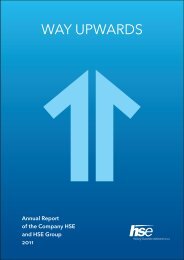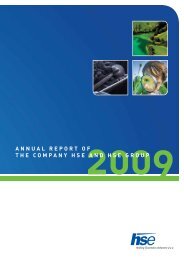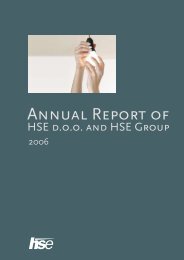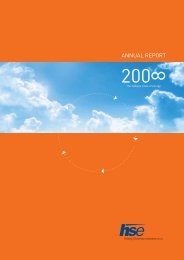Annual report - HSE
Annual report - HSE
Annual report - HSE
You also want an ePaper? Increase the reach of your titles
YUMPU automatically turns print PDFs into web optimized ePapers that Google loves.
5.5.7.7 Inventories<br />
Inventories are carried at the lower of the two: historical cost or net realisable value.<br />
Historical cost includes cost that is composed of purchase price, import duties and direct<br />
costs of purchase. The purchase price is reduced by discounts received. Direct costs of<br />
purchase are costs of transport services, costs of loading, cargo handling and unloading,<br />
costs of monitoring of goods and other costs that can be attributed to directly obtained<br />
merchandise, materials and services. Purchase price discounts comprise discounts<br />
indicated in the invoice, as well as discounts that are received subsequently and refer to<br />
individual purchase.<br />
The value of finished products and work in progress includes total production costs in<br />
the narrow sense, which comprise direct costs of materials, direct costs of services,<br />
direct labour costs, direct depreciation/amortisation costs and general production costs.<br />
General production costs are costs of materials, services, salaries and amortisation/<br />
depreciation, which are charged in the framework of production process, but cannot be<br />
directly connected to developing business effects. A part of production costs in total costs<br />
(materials, services, labour costs and depreciation) is established once per year on the<br />
basis of data from the previous year.<br />
If the prices of the items that are purchased anew in the accounting period differ from the<br />
prices of inventory items of the same class, the first-in first-out (FIFO) method is applied to<br />
decrease the quantities of inventories during the year.<br />
Net realisable value is assessed on the basis of selling price in the normal course of<br />
business reduced by the estimated costs of completion and sales. The write-downs of<br />
damaged, expired and useless inventories are regularly performed during the year by<br />
individual items.<br />
At least once per year, namely as at the date of preparation of annual financial statements,<br />
the evidence on impairment of inventories is assessed. The impairment of inventories is<br />
assessed for each individual type of inventories. Individual types of inventories are classified<br />
as groups of inventories with similar characteristics on the basis of time component of<br />
changes in inventories. In the assessment of impairment for an individual group, the criteria<br />
of professional assessment, further utilisation or sale are used.<br />
5.5.7.8 Impairment of assets<br />
5.5.7.8.1 Financial assets<br />
A financial asset is considered impaired if there is objective evidence from which it is<br />
evident that, due to one or more events, the expected future cash flows arising from this<br />
assets that can be reliably measured have been decreased.<br />
Objective evidence on the impairment of financial assets can be: non-compliance or<br />
violation by the debtor, deterioration of borrowers’ solvency, signs that the debtor will go<br />
bankrupt and disappearance of active market for such instrument.<br />
Impairment of receivables and loans granted<br />
The Group individually assesses the evidence on impairment of receivables.<br />
Whether it is assessed that the carrying amount of receivable has exceeded its fair value<br />
(realisable value), the receivable is impaired.<br />
Doubtful receivables from others are those which are not settled within 180 days after<br />
their due date.<br />
Disputed receivables are those which comply with one of the following conditions:<br />
5 Financial Report of <strong>HSE</strong> Group<br />
<strong>Annual</strong> Report <strong>HSE</strong> 2012<br />
178<br />
• the legal collection procedure began at the court;<br />
• the decision on beginning of enforced settlement, liquidation or bankruptcy is published.<br />
For subsequent write-offs of receivables relevant documents of proof are needed: legally<br />
enforceable decisions of enforced settlement, bankruptcy proceeding, court ruling or<br />
other relevant document.
















